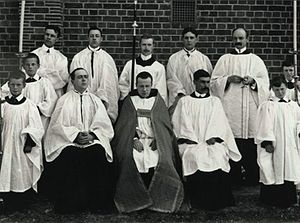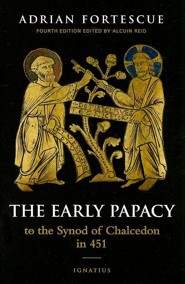I have not had occasion to write a book review in a while, but I recently read a [very] short work by Fr. Adrian Fortescue worthy of some attention called The Early Papacy to the Synod of Chalcedon in 451.
First a few words about the author. Fr. Adrian Fortescue was a very capable linguist and patristic scholar, and something of a frustrate eccentric. He was one of the few clerics in Church history to have shot another man dead and not have been worse off for it. During his travels to Asia Minor and the Middle East, Dr. Fortescue studied the ancient churches of those countries, ecclesial bodies which had long fallen out of the Western mind. Indeed, the re-introduction of the Greek Fathers owes much to Fortescue's introduction to them and his trilogy on Eastern Christendom. Fortescue is most renowned among Catholics nowadays as the author of Ceremonies of the Roman Rite Described, which has gone through so many editions that only the original chides against fiddleback chasubles is recognizable.
 |
| Fr. Fortescue at his parish of St. Hugh's in Letchworth source: Wikipedia |
Above all, Dr. Fortescue was a Roman Catholic priest in early twentieth century England, an England slowly re-building its Catholic community, dealing with the Oxford Movement in the Anglican Church, and the spirit of Vatican I. It was in this setting that Fortescue was challenged to demonstrate the existence of a Papacy before the year 451, the year of the Council of Chalcedon. Many "high" Anglicans became enamored with the Branch Theory derived by Palmer and popularized by the Tractarian Movement. One assertion latent, although not always explicit, in this theory is that the "Papacy" as it exists now is a corruption or a series of politically-driven accretions to the ancient and venerable Bishopric of Rome. Fortescue, obedient to the teaching of Pastor Aeternus, believed the Catholic claim of a continual office through the ages with no apparent reservation, but still thought an inquiry and demonstration of the ancient Papacy worthwhile. He wrote a series of long articles addressing this matter and published them in the Tablet (for my American readers, think an English version of the National Catholic Reporter or Register).
Dr. Alcuin Reid's introduction manages to de-contextualize the presumed context of this collection of articles. One might assume Fortescue intended to unleash a rhetorical flurry of polemical assertions in line with the language and spirit of the First Vatican Council. The post-Vatican I Church was the era of The Early Papacy but certainly not the context. Dr. Fortescue was no ultramontanist. No one with absolutely blind obedience to Rome could write such racy lines as:
"We have stuck out for our position all our lives—unity, authority, St. Peter the rock and so on. I have too, and I believe it; I am always preaching that sort of thing, and yet is it not now getting to a reductio ad absurdam? Centralization grows and goes madder every century. Even at Trent they hardly foresaw this this kind of thing. Does it really mean that one cannot be a member of the Church of Christ without being, as we are, absolutely at the mercy of an Italian lunatic?
".... Give us back the Xth century Johns and Stephens, or a Borgia! They were less disastrous than this deplorable individual."
 |
| [St.?] Photius, archbishop of Constantinople source: wikipedia.org |
Fortescue begins the book by questioning the cutoff date of 451, which he rightly calls arbitrary. One may argue compellingly that while schisms between dioceses existed prior to the Council of Chalcedon, 451 was the first time an entire segment of Christendom (the far eastern churches, in this case) broke communion with the general body. This is not true, as the Assyrian churches split off after the Council of Ephesus decades earlier. The priest muses over the date in a way which exposes his quick whit and humor:
"Go and teach all nations, until Photius is intruded at Constantinople; and I am with you all days, even to the year 451."
Herein we see the faithful assumption of Fortescue: that the Church of ancient times is continuous with the Church of the Middle Ages, which is continuous with the Church today. One Church runs through these eras of history and our Lord's promise to the Apostles held in 451 and still holds today. With this Catholic premise established, Fortescue lays down what he views as the Catholic Church's four essential claims about the office of the Bishop of Rome:
- He is the chief primate throughout all Christendom
- He has episcopal jurisdiction without limit, in contrast to the diocesan jurisdiction of a bishop
- Communion with this man marks you as a member of the Church of Christ, and lack of communion puts you outside the Church of Christ
- He speaks without error on matter of religious belief
Fortescue considers each of these points in an individual chapter, beginning with a short suggestion of what we should see in the patristic corpus concerning that topic. The author warns us not to read too much into arguments from silence, as the Holy Trinity Itself was not defined in any way until 325, but silence concerning the term "Trinity" before Nicaea does not make the earliest Christians followers of Arius.
The exposition on each of these points uses a fair illustration of the relationship between the early Church and the Bishop of Rome, the chief-most of Christian bishops and the successor of St. Peter. He draws heavily on Ss. Cyprian, Ambrose, Augustine, the early Popes themselves, legal decisions from the Roman emperor, and even people from the far eastern churches of Syria and Armenia.
The first point, of Papacy primacy throughout the Church, is so uncontroversial it is not worth my recounting. The second, of the Pope's universal jurisdiction, comes with an important caveat from Dr. Fortescue: the Papacy is not a gradation of Holy Orders above that of bishop; the Pope is a bishop like any other, but his jurisdiction does not end at the walls of the diocese of Rome. This statement subtly tempers the assumptions of any ultramontanist reader.
The chapter on the third point, communion with the Roman bishop, is most elucidating. Use of the term "communion" in the Eastern understanding was less common in Fortescue's age than it is in the post-Vatican II era, so his use of it is significant. As a matter of common sense, our author reasons that one must be in communion with the Pope to be Catholic simply because the Pope is a Catholic. A society which is fragmented, in which people belong to different groups, really no longer exists. The communion of the Church of Christ does still exist and its visible mark is union with the Pope. Fortescue details St. Cyprian's views on schisms in his own time, particularly that of Fr. Novatian, from the Church, specifically from the communion centered in Rome. Similar accounts of St. Ambrose's battle against the Donatists follow.
Most compelling in that chapter is Fortescue's evidence from Eusebius, St. Jerome, and from the Popes themselves: the Bishops of Rome decided who to admit to their communion and no one else. These were men accustomed to obedience.
The final chapter, concerning Papal Infallibility, is also a must-read for many Catholics and non-Catholics who think this charism means that the Pope can bind people to believe whatever he wishes. Fortescue gives us a firm belief among the Christians of antiquity that the Church does not err. The Pope, by virtue of his universal jurisdiction, is encompassed in that belief and the promise of Christ's to guide the Church in "all truth." Infallibility does not, nor should it be construed to, mean that the Pope is intrinsically better than all other bishops and acts as a theological dictator. Indeed, the author observes, if there were no other bishops the Papacy would be quite meaningless.
There are two weaknesses in this very strong little volume.
The first is that Fortescue does not differentiate the various kinds of relationships between the Pope and other bishops. The learned priest amply shows pro-active Papal command of other churches (interventions in Corinth by St. Clement in the first century come to mind, as does St. Julius's dealings with St. Athanasius), but would have done well to say something about how patriarchs and diocesan bishops outside the Roman patriarchate might have viewed the Papacy, a view and a relationship almost certainly different from that of bishops within the Roman patriarchate.
The second is lack of consideration of the Orthodox perspective, which currently holds the Pope to be the first among equals. This is a more historically grounded perspective than the Anglican branch theory and one which will be discussed in ecumenical dialogue for many years to come. Perhaps the next time Roman Catholics, Eastern Catholics, and Eastern Orthodox dialogue, they could react to a book such as this—not for its polemical value, but because it recounts clear examples of the role of the Papacy in ancient times. I suspect Fortescue omitted the Orthodox perspective because he was primarily reacting to an Anglican challenge and living in an Anglican country. He would certainly have been aware of the Orthodox view, though.
On the whole, an informative book which makes a compelling, lucid case for the Catholic Church's claims about the Bishop of Rome in the period before the Council of Chalcedon without being too caught up in the excesses of the post-Vatican I period.


The icon Photius is not of Photius but of st. Basil the Great.
ReplyDeleteOops! Fixed.
Delete